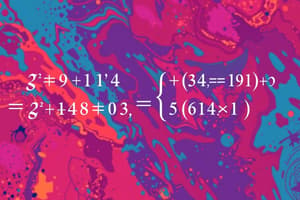Podcast
Questions and Answers
What type of algebra focuses on structures such as groups and fields?
What type of algebra focuses on structures such as groups and fields?
- Abstract Algebra (correct)
- Statistics
- Numerical Algebra
- Linear Algebra
Which of the following measures is not typically included in descriptive statistics?
Which of the following measures is not typically included in descriptive statistics?
- Standard Deviation
- Mean
- Mode
- Correlation Coefficient (correct)
In the context of number theory, which of the following statements about prime numbers is true?
In the context of number theory, which of the following statements about prime numbers is true?
- Prime numbers are only even.
- Every number greater than 1 is prime.
- A prime number has exactly two distinct positive divisors. (correct)
- 1 is considered a prime number.
Which operation represents the process of rewriting expressions into simpler forms?
Which operation represents the process of rewriting expressions into simpler forms?
In inferential statistics, what is the primary purpose of analyzing a sample?
In inferential statistics, what is the primary purpose of analyzing a sample?
What distinguishes a quantitative data type from a qualitative data type?
What distinguishes a quantitative data type from a qualitative data type?
For which distribution is the central limit theorem significant?
For which distribution is the central limit theorem significant?
Which of the following best describes an equation?
Which of the following best describes an equation?
What is a common characteristic of rational numbers in number theory?
What is a common characteristic of rational numbers in number theory?
Which operation is NOT typically performed on algebraic expressions?
Which operation is NOT typically performed on algebraic expressions?
Flashcards are hidden until you start studying
Study Notes
Algebra
- Definition: Branch of mathematics dealing with symbols and the rules for manipulating those symbols.
- Key Concepts:
- Variables: Symbols representing numbers (e.g., x, y).
- Expressions: Combinations of variables and constants (e.g., 2x + 3).
- Equations: Statements asserting equality (e.g., 2x + 3 = 7).
- Functions: Relations where each input has a single output (e.g., f(x) = x^2).
- Operations:
- Addition, Subtraction, Multiplication, Division of algebraic expressions.
- Factoring: Rewriting expressions as products of simpler expressions.
- Solving Equations: Finding values of variables that satisfy the equation.
- Types of Algebra:
- Linear Algebra: Study of vectors, vector spaces, and linear transformations.
- Abstract Algebra: Focus on algebraic structures like groups, rings, and fields.
Statistics
- Definition: The science of collecting, analyzing, presenting, and interpreting data.
- Key Concepts:
- Descriptive Statistics: Summarizing data using measures like mean, median, mode, and standard deviation.
- Inferential Statistics: Making predictions or inferences about a population based on a sample.
- Probability: Study of randomness and uncertainty; foundational for inferential statistics.
- Data Types:
- Quantitative: Numerical data (e.g., height, weight).
- Qualitative: Categorical data (e.g., gender, color).
- Common Distributions:
- Normal Distribution: Bell-shaped curve; important in statistics.
- Binomial Distribution: Model for binary outcomes in a fixed number of trials.
Number Theory
- Definition: Branch of mathematics devoted to the study of integers and their properties.
- Key Concepts:
- Prime Numbers: Natural numbers greater than 1 that have no divisors other than 1 and themselves.
- Divisibility: A number a is divisible by b if there exists an integer k such that a = bk.
- Greatest Common Divisor (GCD): Largest integer that divides two or more integers without leaving a remainder.
- Least Common Multiple (LCM): Smallest multiple that is exactly divisible by two or more integers.
- Theorems:
- Fundamental Theorem of Arithmetic: Every integer greater than 1 can be expressed uniquely as a product of prime numbers.
- Fermat's Last Theorem: No three positive integers a, b, and c satisfy the equation an + bn = cn for any integer value of n greater than 2.
- Applications: Cryptography, coding theory, and computer science.
Algebra
- Branch of mathematics focused on symbols and their manipulation rules.
- Variables represent unknown numerical values, commonly denoted as x and y.
- Expressions consist of variables and constants combined, such as 2x + 3.
- Equations express equalities, such as 2x + 3 = 7, requiring solutions for variables.
- Functions define relationships with a single output for each input, represented as f(x) = x^2.
- Basic Operations include addition, subtraction, multiplication, and division applied to algebraic expressions.
- Factoring involves rewriting expressions in simpler multiplicative forms.
- Solving Equations aims to determine variable values that satisfy the equation.
- Two main types include:
- Linear Algebra, which explores vectors and their transformations.
- Abstract Algebra, which studies groups, rings, and fields.
Statistics
- Science concerned with the collection, analysis, presentation, and interpretation of data.
- Descriptive Statistics summarize data through measures like mean, median, mode, and standard deviation.
- Inferential Statistics involve making projections about populations based on sampled data.
- Probability examines randomness and uncertainty, providing a basis for inferential statistics.
- Data Types are classified as:
- Quantitative: Numerical, such as height and weight.
- Qualitative: Categorical, including gender and color.
- Common statistical Distributions include:
- Normal Distribution, characterized by a bell-shaped curve, crucial for statistical assessments.
- Binomial Distribution, which models binary outcomes in defined trial numbers.
Number Theory
- Field of mathematics focused on integers and their intrinsic properties.
- Prime Numbers are natural numbers greater than 1 that only divide by 1 and themselves.
- Divisibility indicates a number ( a ) is divisible by ( b ) if an integer ( k ) exists such that ( a = bk ).
- The Greatest Common Divisor (GCD) is the highest integer that divides multiple integers without a remainder.
- The Least Common Multiple (LCM) is the smallest multiple shared by two or more integers.
- Significant Theorems include:
- Fundamental Theorem of Arithmetic, asserting every integer greater than 1 has a unique prime factorization.
- Fermat's Last Theorem, stating there are no positive integers ( a, b, c ) that fulfill the equation ( a^n + b^n = c^n ) for any integer ( n > 2 ).
- Applications of number theory are evident in cryptography, coding theory, and computer science.
Studying That Suits You
Use AI to generate personalized quizzes and flashcards to suit your learning preferences.




